TRADE PRESSURES
Adding to the strain is US President Donald Trump’s sweeping tariff plan. In April, Trump imposed a 10 per cent tariff on imports from nearly every country, with steeper duties for dozens of others under consideration.
The aerospace sector, reliant on global supply chains, is especially vulnerable. Trump’s administration is weighing tariffs of 10 to 20 per cent specifically on civil aircraft and parts.
Faury and Ortberg have both called for tariffs to be reset to zero, as had been the case since a 1979 agreement.
“The entire Western aerospace industry considers that would be the best that could happen,” said Faury.
Ortberg told Aviation Week the tariffs are an “added cost” Boeing cannot absorb, warning they come just as the company is trying to rebuild financially.
“I’m hopeful that, as each of these country-by-country negotiations resolve, those tariffs will go away in the long run,” he said.
DEFENCE IN FOCUS
While civil aviation struggles, the defence sector is gaining prominence. European nations have boosted defence budgets amid the war in Ukraine and concerns over Trump’s commitment to NATO.
“The geostrategic environment has led us to bolster this aspect which was in the background in previous years,” said Gifas head Frederic Parisot.
About 75 defence-related firms will participate in this year’s event, showcasing military jets, helicopters and drones.
Highlights include Lockheed Martin’s F-35 stealth fighter and France’s Rafale jet by Dassault Aviation. Nine Israeli companies are expected to exhibit, despite an unsuccessful legal attempt by NGOs to ban their participation over their alleged role in the Gaza conflict.
BOEING UNDER SCRUTINY
The crash of the Boeing Dreamliner has cast a long shadow just days before the show. The aircraft had been seen as a centrepiece of Boeing’s renewed push under new leadership to restore confidence.
Boeing’s absence from the air show’s executive stage will be noted amid investigations, and the crash is likely to dominate conversations throughout the event.
The industry also remains on edge due to unresolved supply chain fragilities dating back to the COVID-19 pandemic, adding further uncertainty to production and delivery timelines.
